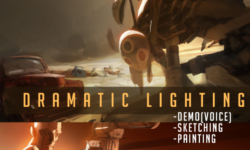Pixel Art Character Animation for Video Games (Spanish, Multisub)
Release date:2022
Author:Daniel Benítez
Skill level:Beginner
Language:Spanish
Exercise files:Not Provided
Bring your characters to life frame by frame in Pyxel Edit
The pixel aesthetic is back with a bang thanks to artists like Daniel Benítez, a video game developer and the cofounder of Fourattic, who keeps it very much alive in his animated creations. In this online course, he teaches you the techniques and processes behind animating a video game character and its surroundings in pixel art using the Pyxel Edit tool.
If you’ve already taken Daniel’s previous course, Introduction to Character Design in Pixel Art, go even further in this one by animating your creations frame by frame and getting to grips with concepts such as timing, anticipation, and motion blur, as well as processes such as exporting and optimizing sprite sheets.
What will you learn in this online course?
Start by getting to know Daniel, who tells you about his career in the world of video game design and specifically in pixel art. He then highlights some of the pixel art animators that have influenced him the most over the years, as well as animators and animation studios in other areas who have been just as inspirational to him.
If you haven’t already done so, download Pyxel Edit. Then Daniel walks you through its interface, with particular emphasis on the most important tools that the program has for developing animations.
Create a project using tilesets in Pyxel Edit. Discover what tiles are and what they are used for in animation.
The first action for your character is the waiting animation, starting off with basic shapes and silhouettes. Daniel uses some examples to explain what timing is within the context of animation, as well as what keyframes and motion tweens mean.
Next, create an animated walking cycle. Examine what it is exactly and what function it has in a video game before animating your character and reviewing animation concepts from the previous lesson.
The third and final character animation is the attack. Daniel introduces you to concepts and techniques like anticipation, motion blur, and easy in/out, which are essential for quality and smoothness in your animations.
Animate your character’s surroundings using techniques such as modular animation and pixel-by-pixel animation.
Now you have all your animations made, learn how to export them separately or together in GIF format using Pyxel Edit. Find out how to export them so they can be used in video games by way of sprite sheets. Daniel wraps things up by sharing some more programs that are useful for this sprite sheet developing process.
What is this course’s project?
Animate a video game character, focusing on three of its most important states: waiting, walking, and attacking. Create some lightly animated surroundings using different techniques than those used for the character.
Who is this online course for?
Designers, illustrators, animators, and anyone who wants to learn more about animation for video games using the pixel-art technique.
Requirements and materials
You need basic knowledge of character design and an understanding of Pyxel Edit or programs that offer a similar function such as Adobe Photoshop or Flash.




 Channel
Channel





